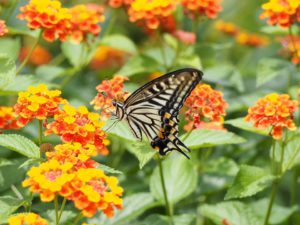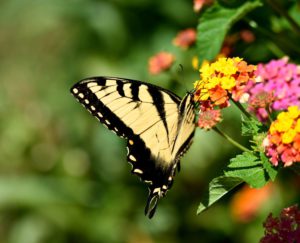Tips on Caring for Swallowtail Butterflies

The swallowtail butterfly is popular among butterfly lovers, these garden beauties will have your garden area buzzing with excitement as you create a natural habitat from your backyard, a garden oasis with the presence of the swallowtail is so inviting as you make these beneficial insects feel right at home.
Creating a habitat of this kind is a great way to start a wildlife garden providing a home as well as a food and water source for them, this is a great way to bring balance to our ecosystem. For more on the care of swallowtails continue reading to have much success when caring for them.
History of swallowtail butterflies
The swallowtail butterfly species is a large family that falls under the family Papilionidae. This family is so large that it comprises more than 550 which is very huge. The swallowtail can be found on every continent except Antarctica, some species have scent glands when disturbed will release a foul substance.
Many species of the swallowtail can be found in meadows, arid deserts, mountain areas, and forests. Because of their beautiful colors, they are much prized and sorted after by collectors. Swallowtails make between 1-2 flights from April-October in the Northern regions and 3 flights in the Southern regions.
Swallowtail Habitat
The black swallowtail can be found in suburbs, meadows, fields, roadsides, marshes, and parks.
The life cycle of swallowtail butterflies

There are 4 stages in the life of a swallowtail, these stages are egg, larva, pupal or chrysalis, and adult which is the butterfly. The female lays her eggs atop or on the undersides of the host plant’s leaves, in about 3-5 days the eggs hatches and the larva emerges. The larva is in the caterpillar stage and will feed on the leaves of the host plant.
The larva will consume the leaves very quickly and because of its huge appetite, it grows rapidly shedding its skin. In about 2 weeks the caterpillar begins to pupate, they then spin silk which they wrap themselves in forming a chrysalis attached to the host plant by a single thread.
Inside the cocoon, they undergo metamorphosis and a beautiful change begins to take place. This process may last for a while, emerging from the cocoon they are transformed into beautiful butterflies but they can’t fly yet because they have to pump fluids into their small wings. Once fluids are pumped into their wings become bigger and stronger this process will allow them to take flight.
Affiliate Disclaimer
As the owner of this website, I’ve tracked down special deals for some of the products mentioned here. When you use the links on this page to make a purchase I may get a small commission and you will get a great bargain. It’s a WIN-WIN for both of us.
Attracting the swallowtail butterfly to your garden
You have decided to attract the swallowtail to your garden but don’t know where to start well below we will be looking at some tips on what to do to have your garden filled with these beautiful butterflies.
2. Install plants in this location, plants that are native to your zone and attract swallowtails. Some of these plants include lantanas, zinnias, purple coneflowers, bee balm, thistle flowers, butterfly weed, sunflowers, Joe Pye weed, butterfly bushes, parsley, etc…
3. Plant tall grasses such as Panicums, Carex, Schizachyrium, Japanese silver grass, Muhlenbergia,
4. Providing a water source is so important, filling a dish or two with water and placing them in your garden or a birdbath will do.
5. Placing rocks in this area will give them a place to rest.
12 Swallowtail fun facts
Here are some cool fun facts about the swallowtail butterfly.
1. As the swallowtail ages, it changes color.
2. There are believed to be more than 550 species of swallowtail.
3. The female tiger swallowtail has a dark color which gives them the appearance of a poisonous pipevine that keeps predators away.
4. Swallowtails can be found on every continent in the world.
5. It’s believed that although the tiger swallowtail may lose one of its wings it still has the ability to fly.
6. The swallowtail pupae overwinter by attaching to the lower stems of plants.
7. This butterfly goes by many names such as lime swallowtail, lime butterfly, and lemon butterfly.
8. It’s believed that the black and white patterns of the swallowtail caterpillar act as camouflage so birds can think that it’s (birds) their droppings.
9. The chequered swallowtail doesn’t have a tail.
10. The Braoniinae Swallowtail is only found in Mexico.
11. These butterflies are large.
12. The swallowtail is the largest species of butterfly in Britain.
Additional information on the swallowtail butterfly
1. Placing a 2-3 inch layer of mulch around garden plants will help to keep weeds down along with these other benefits.
2. Don’t use harmful pesticides which can cause much harm to swallowtail butterflies and beneficial insects.
3. The use of beneficial insects is a great way to bring garden insect pests under control while protecting the swallowtail.
4. Installing plants in masses or bunches will make your colorful friends feel right at home.
5. Using native plants that attract the swallowtail will draw them to your garden like a magnet.
6. Using organic or systemic fertilizers will work wonders. Before using fertilizers read and follow the manufactures label.
7. Filling a bowl or dish with overripe fruits will attract them.
8. Don’t squash caterpillars because they may just be the babies of the swallowtail.
9. Water garden plants from the ground level so as not to knock the caterpillar of plants.
The final word about the swallowtail butterfly
Using your garden as a natural habitat for the swallowtail is a great way to connect with nature outdoors while helping to bring balance to the ecosystem. One of the things that are affecting wildlife is the destruction of their homes making way for roads, parks, and other infrastructures.
Let’s do our part in making it much easier for wildlife, so the next time you plant a garden or maybe refurbish it remember that our wildlife is depending on us to give them a helping hand so they can find a place for shelter, food and to raise their you. Wildlife gardening is so amazing because of how it contributes to the ecosystem let’s join hand in hand with each other along with nature doing our part by providing a home for our colorful friends.
About the author
Norman loves being in the garden, both at home and for his job....
he is 'Natures Little helper' being outdoors, growing his vegetables and flowers from an early age.
Now having spent over 22 years in the profession he want to give some of his knowledge to others...
his vast array of hints and tips you will find scattered over this site will help you no end growing plants in your garden.

The Swallowtail Butterfly is beautiful! I love when I see them stop by in our yard for a while during the day, it is always very peaceful once they are floating around you 🙂
These are some awesome facts here, I am going to bring my son in and have him list a few of these features as part of his homeschool plan tomorrow, maybe afterward we’ll take him out to go try to spot some outside.
I am excited to try some of the attraction tricks and see if maybe we can get a few more butterfly friends to stop by. Thanks a lot!
So happy to meet you and I am so glad to help. It is so good to know that you have and interest in wildlife and also involving your son which is so great. It is good to educate the next generation so they can work along with and preserve these species. Wishing you good success with your wildlife garden project and if it is no bother I would love to know how it goes. Thanks again and have a good evening.
The Swallowtail’s patterns are magnificent. Definitely a beautiful look for any garden. It’s mindblowing that there are so many species of Swallowtail and each would be a great addition for any garden or just to be able to observe in general. Also cool that it can change color as it ages plus possess a unique ability to ward off predators. There’s a lot to like with the Swallowtail and they don’t seem to be too hard to attract to a garden or place of residence.
The swallowtail is a beautiful butterfly that can bring life to a garden setting as we watch them in their natural habitat. Nature is so amazing and watching and observing them we can learn so much. I am so happy to help. All the best to you.